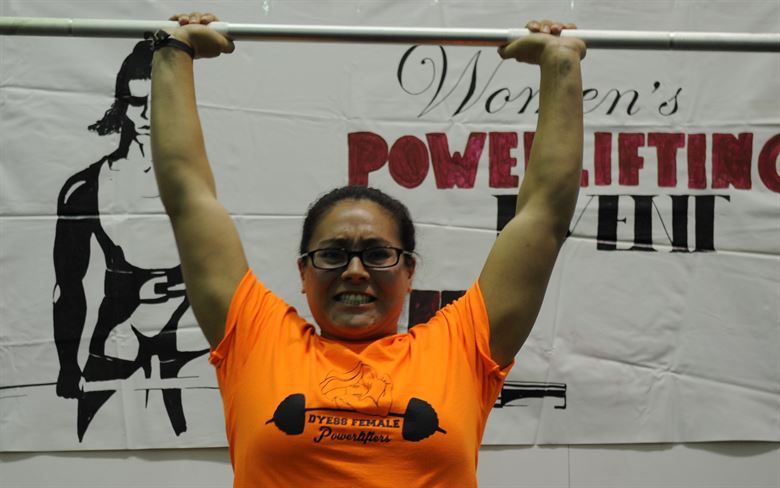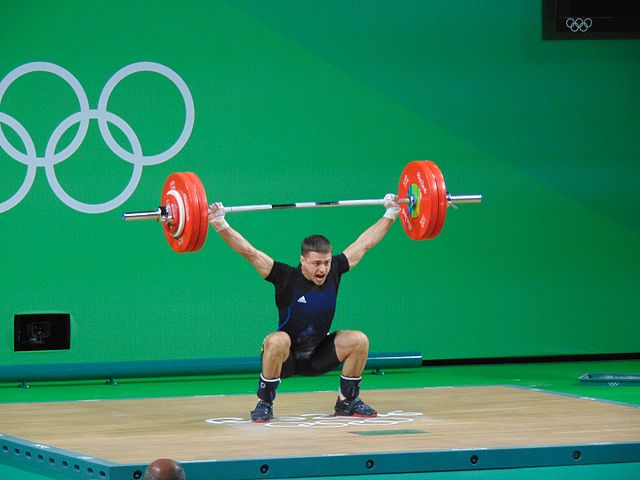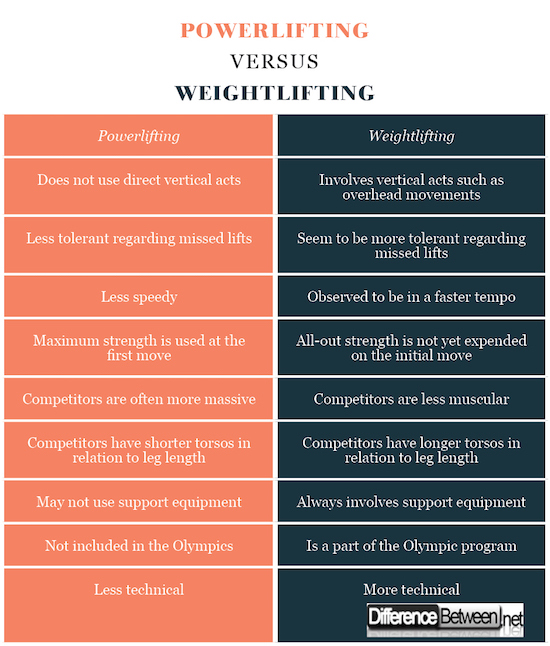Difference Between Powerlifting and Weightlifting
Powerlifting and weightlifting are two of the most popular sports which involve lifting heavy objects. For many, these may seem just the same but they place distinct demands on the athletes.
Generally, powerlifting is concerned with completing three controlled lifts and competition-wise, it can be equipped or unequipped (also known as class lifting or raw lifting). On the other hand, weightlifting is more technical by focusing on excellent methods in achieving two ballistic lifts.
The following are the pertinent equipment in these lifts:
- Barbell: Steel Bar with larger-rotating sleeves holding rubber coated weights
- Bumper Plates: Rubber-coated weight plates which weigh from 10 kg to 25 kg in 5kg increments.
- Competition Iron Plates: Smaller iron plates being added to level up the competition
- Collars: Each collar weighs 2.5 kg. They are placed at the ends of the bar to secure the weight plates.
- Singlet: One-piece body fitting leotard worn by the athletes
- Weightlifting Belt: A belt with a maximum of 120 mm width worn for lower back support
- Chalk: Rubbed on the hands and neck to prevent the bar from moving
- Tape: Often wrapped around the thumbs and wrists to prevent calluses and facilitate joint movement
- Weightlifting Shoes: Specialized shoes with raised heels, metatarsal straps, and rigid soles
What is Powerlifting?
The history of powerlifting dates back to the strength training regimens of the early Greece and Roman civilizations. It became an official sport with its first actual national meet in 1964 through the sponsorship of the York Barbell Company. Back then, the sport was popularly known as “odd lifts”. Currently, the competitors are classified according to their body mass with men having nine weight categories while women have eight.
The competitors are given three attempts at maximal weight on the following three lifts:
- Squat: The barbell is positioned on the shoulders while the knees are bent at a right angle; after which the competitor stands back up.
- Bench Press: While lying on his back, the bar is lowered to the competitor’s chest level and pressed to arm’s length.
- Deadlift: As its name suggests, this is done by taking the barbell from the floor and lifting it with arms straight while standing in a full upright position.
What is Weightlifting?
Weightlifting traces its origins in several early civilizations such as those of Greece, China, and Egypt. The current sport is largely based on the traditional European competitions in the 19th century. It is also known as Olympic weightlifting as it is included in the modern Olympic program in which athletes perform single lifts with barbells. The weightlifters are given three attempts and the total score of the two most successful attempts is recorded. They are classified according to their body mass and there have been eight divisions for both male and female competitors. This sport specifically tests explosive strength; hence, executed faster.
Weightlifting consists of the following two competition lifts:
- Clean-and-Jerk: This involves two parts; the barbell is first taken from the floor and is lifted to shoulder height; after which the weight is pushed overhead.
- Snatch: This is a single-part lift which directly lifts the weight overhead after picking it up from the floor.
Difference between Powerlifting and Weightlifting
-
Competition Lifts in Powerlifting and Weightlifting
Weightlifting involves overhead movements such as snatch and clean and jerk. On the other hand, powerlifting does not utilize direct vertical acts as it makes use of the squat, bench press, and deadlift moves.
-
Toleration of Missed Lifts
Weightlifters seem more tolerant with missed lifts as this risk is understandable in coming up with the most beneficial total. However, this specific perspective may not be that understood by powerlifters.
-
Speed of Powerlifting and Weightlifting
As compared to powerlifting, weightlifting is often observed to be executed in a faster tempo as it tests explosive strength. Powerlifters usually have the luxury of time to make their movements more successful.
-
Strength Utility
For weightlifters, the first part of the lift is not that strenuous. On the contrary, powerlifters invest much strength on the first move as much as possible.
-
Muscle involved in Powerlifting and Weightlifting
As compared to weightlifters, powerlifters tend to be more massive as their movements require more muscle-work.
-
Torso Length in Relation to Leg Length
As compared to weightlifters, most powerlifters have shorter torsos in relation to leg length to help them lift heavier weights in squat and deadlift competitions.
-
Range of Motion
Weightlifting encompasses a wider range of motion since there is more mobility during the execution. For instance, in the snatch and the clean and jerk lifts, the competitors show ballistic limits as well as grace in their dynamic movements. However, powerlifting has a more restricted range of motion specially when the competitors perform while lying on their backs during the bench press movement.
-
Support Equipment
Unlike weightlifters, powerlifters may not use support equipment during the “raw-lifting” category competitions.
-
Olympics
Powerlifting is not included in the Olympic program while weightlifting is.
-
Technicality
As compared to powerlifting, weightlifting is more technical as it focuses on great techniques and is governed by stricter standards.
Powerlifting vs Weightlifting
Summary of Powerlifting vs Weightlifting
- Both powerlifting and weightlifting are popular sports which may be often viewed as very similar but they have certain distinctions.
- As compared to weightlifting, powerlifting does not involve direct vertical acts.
- Weightlifting seems to be more tolerant regarding missed lifts.
- Unlike weightlifting, maximum strength is expended on the first powerlift move.
- Powerlifters are usually more muscular than weightlifters.
- Weightlifters often have longer torsos in relation to leg length.
- Unlike weightlifting, powerlifting has an “unequipped” category.
- Weightlifting is generally more technical than powerlifting.
- Difference Between Hematoma and Melanoma - February 9, 2023
- Difference Between Bruising and Necrosis - February 8, 2023
- Difference Between Brain Hematoma and Brain Hemorrhage - February 8, 2023
Search DifferenceBetween.net :
Leave a Response
References :
[0]Austin, Dan, and Mann, Bryan. The Complete Guide to Technique, Training, and Competition Powerlifting. Windsor: Human Kinetics, 2012. Print.
[1]Carroll, Brian. 10/20/Life: The Professional’s Guide to Building Strength has Gotten Even Bigger and Better. USA: Create Space Independent Publishing, 2017. Print.
[2]Everett, Greg. Olympic Weightlifting. Sunnyvale: Catalyst Athletics Inc., 2017. Print.
[3]Image credit: https://media.defense.gov/2013/Nov/01/2000899842/780/780/0/131026-F-KI416-001.JPG
[4]Image credit: https://upload.wikimedia.org/wikipedia/commons/thumb/a/a9/Rio_2016_-_Weightlifting_men%27s_69_kg_%2829049354630%29.jpg/640px-Rio_2016_-_Weightlifting_men%27s_69_kg_%2829049354630%29.jpg



